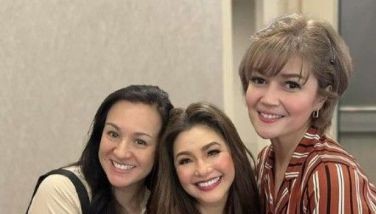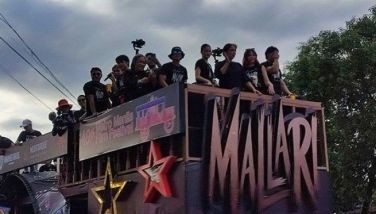Ana Capri: Into the psyche of a Sama d’Laut
MANILA, Philippines – “Para silang isda sa tuyong lupa. (They are like fish on dry land).”
This is how Ana Capri describes Sama d’Laut, the Philippine ethnic group her character belongs to in the Louie Ignacio film Laut. It recently opened the third Singkuwento International Film Festival Manila Philippines (SIFFMP), which runs until Feb. 27 at the National Commission for Culture and the Arts (NCCA).
“You put them in an environment, which is not theirs or they are not accustomed to,” she says. “They struggle in surviving (that kind of life.)”
Ana has simply stated a reality that some marginalized and minority groups like Badjaos, Aetas and Mangyans in the Philippines have to deal with. This has become a driving force for the actress to be a portal in telling a story that is teeming with reality bites.
“It’s a humbling experience,” says Ana of playing mother-in-law to Barbie Forteza's character Nadia, who is in dire poverty. “They cannot afford to have their own toilets although there’s a common toilet in their community… There is a need to educate them about (personal) hygiene and health, (the importance of finishing) education and (having a decent) livelihood. Their means of (survival) is through begging — paghingi ng limos. They sell anything or what is available.”
And begging is one issue Ana’s character and her lover (played by Pinoy Big Brother housemate Ricco Barrera) argue about in the movie.
“I have a boyfriend, who is an outsider from my culture,” she shares. “He tells me to stop begging from passers-by. He expresses his intention that when we get married, he will not allow me to do it. My character responds to him by saying, ‘Bakit pinakikialaman ko ba ang pagiging tricyle driver mo? Ano ang problema mo sa trabaho ko? Trabaho din naman ang pamamalimos.”
When Ana was asked about the reason of her character’s family leaving their place of origin, she replies, “perhaps there’s a problem and so they are encouraged to migrate. Then, they put up their own community.” According to some reports, Sama d’Laut’s “exodus” can be attributed to ethnic war and persecution and poverty.
To get into the psyche of a Sama d’Laut, Ana says she was given the freedom to “do my own research of the people my character is representing. I was also lucky that direk (Louie) provided me, us, materials like photos of the people and their place, and studies. It was easy (to get into the character) because the place where we shot the scenes afforded us to blend in with them (Sama d’laut). It is their real community. The process required in studying a character was accessible and the needed tools (to build the character) were given. I was able to get points on how they speak, how they act and how they live.”
Ana’s Sama d’Laut role is a welcome addition to her myriad of small and big screen characters.
“Before I have done a series of teacher roles,” she recalls. “But you’ll see different teachers at the end of the day. It’s also exciting if you’re doing characters belonging to the (same category).”
Touted as a reliable actress, Ana shares some tips with showbiz aspirants. “I listen and observe, which is very important. I listen to my director, (consider) his insights and inputs. I also do my own research. I always try to put myself into the character and ask, ‘Kung ako ba yan, paano ko ba yan mararamdaman?’ I will detach myself from it and relate to some parts of me kung ano ang character niya at hindi ako dapat maging yan. I will remove my feelings as Ana and be the character, let’s say Maria… Every time you get a role, you always consider it your last. So your excitement and gusto will be there at magagawa mo siya ng maganda, para di siya maging flat. As much as possible, you try to be at your best, especially if you have the luxury of time and energy (to study your role).”
Laut, however, will always have a special place in Ana’s acting book.
“The movie serves as an advocacy, (you know) raising an awareness that we have minorities (in our midst). To me, as part of the majority, we do not know that their culture and way of living exist.”
Ana adds that Sama d’Laut, portrayed through the lens of direk Louie, are caught between staying true to their traditions and accepting modernity. She says they still live in stilt houses. They dress up like city-dwellers. Women can marry once they have their monthly period, while men are allowed to start a family if they have jobs and are financially independent. What touches Ana’s heart the most is, Sama d’Laut’s contentment in living that kind of life.
“At the end of the day, they are Filipinos,” Ana says. “So whatever human rights I’m enjoying are also their rights.”
(SIFFMP will also go to UPFI UP Film Center from March 2 to 4 and March 7 to 8.)
- Latest
- Trending































